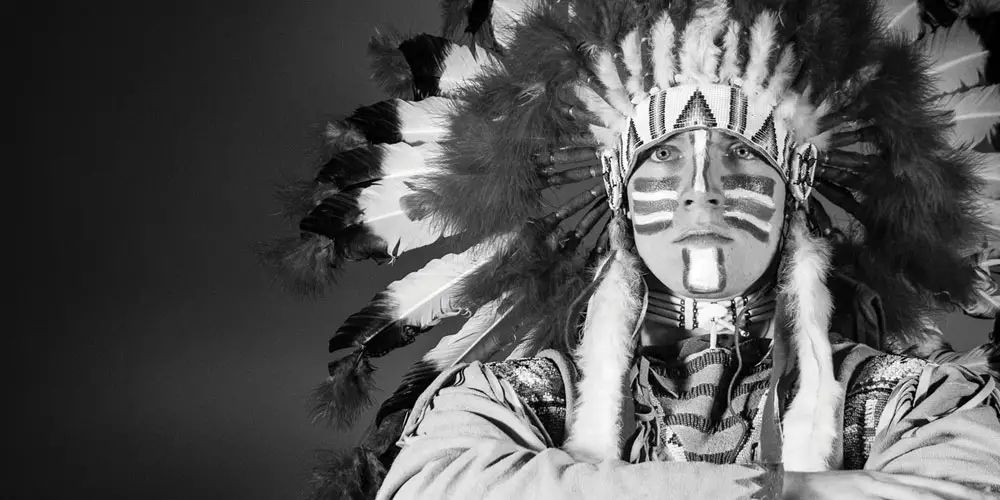The stands are packed in State Farm Center. A sea of blue and orange erupts in the famous “I-L-L-I-N-I” chant, as the students of the University of Illinois cheer on their Fighting Illini. Hidden amongst the roaring fans is a man dressed in regalia, headdress full of red, white and black feathers, standing in the Alma Mater pose.
Ten years ago, Chief Illiniwek would have ran onto the court at halftime to perform the traditional dance to the “Three in One,” a blend of three different university songs played by the U of I’s band. Today, however, he remains in the crowd.
In February 2007, the University of Illinois issued a statement discontinuing the performances, name and logo of Chief Illiniwek, the former symbol of the school. In order to remain compliant with the NCAA’s ban on institutions using American Indian imagery while hosting events for the organization, U of I chose to terminate the use of the Chief, a symbol that had been engrained in the university’s culture since 1926.
Despite the ban though, the Chief has lived on. A student still comes to every game, appearing in the crowd dressed in full regalia, posing for pictures and even performing at local high schools.
Currently, the student Chief is Bennet Kamp, a sophomore and one in a long line of University of Illinois alumni.
“The University of Illinois has always been a big piece of my life,” Kamp says. “I only applied to one school.”

Bennet Kamp was chosen in February 2016, after an extensive auditioning process, to become the newest “unofficial” Chief Illiniwek.
The student portraying the Chief is chosen by the Council of Chiefs, an organization composed of alumni who formerly performed as the Native American symbol. In order to audition, students were required to learn the history and traditional dance of Chief Illiniwek, as well as interview with three members of the council.
“We had to learn the history of the Illini Confederation and specifically the Peoria Tribe of Oklahoma,” says Kamp.
The Peoria Tribe are the closest living descendants of the Illini Confederation, the group of tribes believed to be the inspiration behind the Illinois namesake, who were forced to move to reservations in Oklahoma in the nineteenth century.
Chief Illiniwek became the official symbol of the university on October 30, 1926, when a Native American war dance was performed during the halftime of the football game against the University of Pennsylvania. Ray Dvorak conceived of the idea, and Eagle Scout Lester Leutwiler created the costume and performed the dance based on his experience in the Boy Scouts.
Since 1926, 39 students have represented the Chief, including one woman, Idelle Stith, in 1943, who took on the role of “Princess Illiniwek” due to a shortage of men during World War II.
According to the Council of Chiefs, the word “Illiniwek” translates to “we are men,” or “the complete man.” Its usage has always been justified by the student body as honoring Native American culture and representing a sense of togetherness among the university.
To Ben Kamp, the Chief has always represented unity. “The Illini Confederation was formed to combat this new establishment of settlers coming in. It’s always been, even in its history, a symbol of unity and coming together, and that’s really representative of what the Chief has meant to the university over the last 90 years,” Kamp says.
To Ivan Dozier, the portrayer of Chief Illiniwek from 2011 to 2015, the Chief represents honor. “It represents the best aspects of our school, our past and present students, and the Native peoples that came before us. The symbol links us all together in a way no other symbol could, and the strength and power only reflects the best sides of Illinois. The Chief shows us that we are part of something greater than ourselves, and that being a student at Illinois sets us apart with quiet dignity,” Dozier says.
Not everyone shares in this set of beliefs, however.
To some, this idea of unity is far from Chief Illiniwek’s real representation. Instead, to them, the symbol is one of racial discrimination and cultural appropriation. “All race-based human mascots are offensive and insulting racial stereotypes,” says Jay Rosenstein, Media and Cinema Studies professor of the University of Illinois. “That goes double for a public institution that claims to respect and be a welcoming place for all people.”

Rosenstein created the documentary “In Whose Honor?” about the use of American Indians as sports mascots, and the film aired nationally on PBS, garnering much praise and a Peabody Award nomination. He’s been very outspoken on the subject of Chief Illiniwek over the years.
To Rosenstein, arguments of symbolism hold little water. “What he represents in an individual’s own mind or imagination is irrelevant,” he says. “According to the NCAA, the governing body for college athletics, after several years of research on the subject, they concluded that Chief Illiniwek is ‘hostile and abusive.’ What more needs to be said?”
The controversy over Chief Illiniwek goes all the way back to the mid-70s, when Citizens for the American Indian Movement (AIM) stated that the Chief was a “mockery not only of Indian customs, but of white people’s culture,” and that “the continued use of Indian history as entertainment degrades the Indian and disgraces the white race by revealing an ignorance of tribal cultures.”
Then, in 1989, Spokane Tribe member Charlene Teters began protesting the usage of Chief Illiniwek at athletic events after watching the reactions of her children seeing him perform during halftime. Her daughter was cringing in her seat, and Teters made it her mission to educate the world on the racism involved in using Native American imagery.
Many students had stated that the use of Chief Illiniwek was creating a hostile learning environment for Native American students and, in 1994, members of the Native American Student, Staff and Faculty for Progress (NASSFP) accused the university of being in violation of Title IV of the Civil Rights Act of 1964, claiming discrimination and failing to respond appropriately to the complaints of the students.
When the NCAA became involved in January 2006, the university tried to extend the usage of the symbol as long as it could, requesting an extension into May, but the National Collegiate Athletic Association wouldn’t hear their appeal. Finally, in 2007, Chief Illiniwek, then played by Dan Maloney, current President of the Council of Chiefs, danced his final dance during the football game against Ohio State University.
While there has been a push by the Council of Chiefs and some students to reinstate the symbol to the university, it hasn’t gone anywhere yet. There are still universities, such as Florida State University, who are allowed to use Native American imagery because they maintain a relationship with the representative tribe (in FSU’s case, the Seminole Tribe) and have their support.
The Council of Chiefs had hopes of working together with the Peoria Tribe to come to a compromise and establish a Chief Illiniwek that represented their culture in a way that honored it, but John Froman, the current Chief, has stated that the tribe is not willing to participate without the endorsement of the university.
They were pitched the idea of a new Chief that “would be a respectful portrayal of the Peoria culture.” According to the Council, that was obviously not the previous Chief. “The previous Chief was not in any way representative of Peoria culture,” they said to Froman. The previous Chief was dressed as a member of the Sioux tribe—not at all representative of Plains Indians like the Illini Confederation.
“Bringing back the Chief is not a way of respecting the Native American culture,” Froman said in an interview with a local Champaign newspaper.
The controversy has certainly not ceased with the discontinuation of the Native American imagery. The current climate of the University of Illinois is one of division on the opinion of Chief Illiniwek.
In a poll that was conducted in February 2008, it was found that, of the approximately 23 percent of the student body who participated, 79 percent showed support for Chief Illiniwek, while 21 percent were opposed. According to Rosenstein, the mascot is opposed by anywhere from 25-35 percent of all the student body and alumni.
While it seems that more are in favor of the Chief than against, both sides seem to agree that there is a lack of education involved in the usage of the symbol.
“I will say that most of the community is pretty uneducated about the full history and symbolism, which is unfortunate, but gives us a clear goal of education,” Ivan Dozier says. “Not a single person I’ve talked to over the years who is against the Chief has had all of their facts correct. To me this paints a clear picture—that we need to get everyone educated about the issue first and come to opinions later.”
Dozier also spoke on the harassment he’s received because of his portrayal as the Chief. “I’ve received a couple death threats here and there,” Dozier says, “as well as a lot of people saying that I’m a disgrace to my heritage or that my ancestry is made up.”
The heritage he’s referring to is his connection to his Cherokee ancestors. Dozier is one of only two (the other being Idelle Stith) who have been part Native American. He believes that his heritage has put him in an interesting position, in which he’s able to hear and understand the views from both sides of the controversy.
“I think that my heritage helps break down stereotypes a little bit. Too often people assume that I am against the Chief when they learn of my heritage,” Dozier says, “so I think that my unique perspective can help people on campus to judge issues like these on an individual basis rather than a racial one, which I think is an important mindset to try to foster for pretty much any issue, really.”
Being Native American, Dozier has been met with conflicting opinions by some of his family members. “The silver lining there is that I trust and respect the views of my family, and so I have had the chance to open a dialogue and get to understand why a lot of people are offended by the Chief,” Dozier says. “I think that opportunity of discussion and understanding is valuable to share with a community that is clearly divided.”
Bennet Kamp doesn’t see such a clear division amongst the students. “I wouldn’t say that there is a split in the student body,” Kamp says, “more of a greater indifference.” Kamp has observed, through his time as the current Chief, a general positivity from those who have had parents or family members attend the university. Those who are against it, he thinks, are those who haven’t had a personal experience with the symbol.

Megan Schaefer, a senior at the University of Illinois, does have a personal connection with Chief Illiniwek. “I grew up going to games here, basketball especially,” Schaefer says. “When you’re a little kid, seeing the dance and everything was so cool. I didn’t actually like sports, so the halftime dance was basically the highlight of the long road trips.”
While she maintains that part of her misses the fond memories she had with her family, she believes the university did the right thing in banning Chief Illiniwek’s usage.
“When a group says, ‘Look, you’re disrespecting us and misappropriating our culture,’ you don’t just get to decide that you’re not,” Schaefer says.
Professor Jay Rosenstein attributes some of the blame to the University of Illinois’s lack of involvement. “I would say a majority of the current student body would support the Chief. That is partly because the institution hasn’t done anything to educate its students about the issues relating to Chief Illiniwek and American Indian mascots and imagery in general,” he says. “I think if that was done, it would probably be about an even split among students.”
Ivan Dozier is in agreement with the professor on this particular issue. “I think the University could do much more to defend the symbol and its proud history by properly educating the public on its many nuances.”
What can’t be argued is that Chief Illiniwek has taken on a life outside of the university. Whether it’s in praise or in condemnation, talk of the usage of the Native American imagery extends far beyond the campus perimeter.
“The Chief has never just been a university symbol, it’s always been a very big impact on the community,” Kamp says. “The surrounding cities don’t have a sports team. U of I has always been their team and the Chief has always been their symbol.”
The community, specifically the alumni of U of I, are dedicated to the chiefs. Many families are just like those of Ben Kamp—they pass down the Fighting Illini as another family tradition. “There is a pool table in my family’s basement completely upholstered in orange and blue,” Kamp says. “I had no choice but to come to this school.”
The issue of cultural appropriation has also made its way into the national conversation. The use of Native American imagery for sports teams like the Washington Redskins is heavily debated.
According to Rosenstein, cultural appropriation can be summed up in the same way he explained it to his four-year-old daughter. “How would you feel if someone dressed up like you,” he says, “and while they were pretending to be you, acted in a stupid and foolish way that you would never act?”
He says that the issue of cultural appropriation is especially significant to Native Americans because there’s such a long, ugly history between them and white institutions. “Ever since the appearance of Europeans in North America, cultural appropriation of Native Americans has been occurring,” he says. “Ask yourself this: If you were them, wouldn’t you be more than a little bit tired of it by now?”
There seems to be no clear answer to this controversy, as organizations like Students for Chief Illiniwek continue to fight to reinstate the Chief as the official symbol of the university, and the NCAA and the university continue to enforce the ban. For now, the University of Illinois continues to move forward without a mascot, but are actively polling students for opinions.















